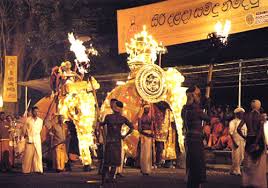Directory
Kandy Esala Perahara
Esala Perahera (the procession of Esala) is the grand festival with elegant costumes held in July or August in Kandy, Sri Lanka. It has become a unique symbol of Sri Lanka. It is a Buddhist festival consisting of dances and colourfully decorated elephants. There are fire-dances, whip-dances, Kandyan dances and various other cultural dances. The elephants are usually adorned with lavish garments. The festival ends with the traditional diya-kepeema ritual, a water cutting ceremony which is held at the Mahaweli River at Getambe, Kandy.
The Esala is believed to be a fusion of two separate but interconnected "Peraheras" (Processions) – The Esala and Dalada. The Esala Perahera, which is thought to date back to the 3rd century BC, was a ritual enacted to request the gods for rainfall. The Dalada Perahera is believed to have begun when the Sacred Tooth Relic of the Buddha was brought to Sri Lanka from India during the 4th century CE, eight hundred years after the passing away of Lord Buddha.
According to tradition, the Tooth Relic was taken in procession to Sri Lanka by Princess Hemamala & Prince Dantha.
Modern Perahera
The Modern Perahera dates back to the reign of the Kandyan King, Kirthi Sri Rajasinghe (1747–1781). During these times, the Tooth Relic was considered private property of the King and the public never got a chance to worship it. However, King Rajasinghe decreed that the Relic be taken in procession for the masses to see and venerate.
After the Kandyan Kingdom fell to the British in 1815, the custody of the Relic was handed over to the Maha Sanga (the Buddhist Clergy). In the absence of the king, a lay custodian called the "Diyawadana Nilame" was appointed to handle routine administrative matters
The Procession
The Kandy Esala Perahera begins with the Kap Situveema or Kappa, in which a sanctified young Jackfruit tree (Artocarpus integrifolia) is cut and planted in the premises of each of the four Devales dedicated to the four guardian gods Natha, Vishnu, Katharagama and the goddess Pattini. Traditionally it was meant to shower blessing on the King and the people.
The Kumbal Perahera
For the next five nights, the "Devale Peraheras" take place within the premises of the four Devales with the priest of each Devale taking the pole every evening, accompanied by music and drumming, flag and canopy bearers, spearman and the Ran Ayudha, the sacred insignia of the Gods.
On the sixth night, the Kumbal Perahera begins and continues on for five days. Initially, the Devale Peraheras assemble in front of the Temple of the Tooth, which is Sri Lanka's most important Buddhist Shrine and where the Buddha’s Sacred Tooth Relic has been kept since the 16th Century) with their insignias placed on the ransivige (a dome-like structure) accompanied by the Basnayake Nilames (the lay custodians of the Devales).
The relic casket, which is a substitute for the Tooth Relic, is placed inside the ransivige affixed to the Maligawa Elephant, a
Listing Details
Address
Telephone
94812205839














